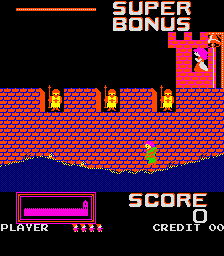Although most people will remember the various home ports for Sinclair ZX Spectrum, Amstrad CPC and BBC Micro, Hunchback was originally released by Century Electronics in 1983 as an arcade machine. The game itself was a relatively simple “pitfall” style platformer, with multiple left to right flip screens, each one featuring a number of challenges to overcome, in order for for Quasimodo to rescue Esmerelda.

The origins of the game are however more interesting, given that the original theme of the game was apparently nothing to do with the famous Victor Hugo novel. As the story goes, the original artist had penned a fairly lumpy version of Robin Hood, that appeared to look more like a Hunchback. After the artist left the company, it was decided to rename the game to fit the artist’s rendition of the main character in the game. Looking back at the game with this in mind, it does appear to fit based on the available clues:
1) Liberal use of arrows in the game as hazards, and the bright green costume, very Robin Hood
2) The seemingly “bolted on” nature of the bells at the of each stage, and fact that the castle ramparts seem out of place on Notre Dame cathedral
3) The soldiers are dressed as crusaders, as featured in Robin Hood, from a war that ended in 129, and the Victor Hugo book is set in 1482
This does not detract from a great game, that clearly captured the public’s imagination, everyone accepting the premise that Quasimodo was on a jaunt to rescue Esmerelda, and nothing to do with Nottingham Castle, Robin or Marion.
The game itself was quite tricky, with increasing levels of challenge as the game went on, most reliant on perfectly timed jumps across ramparts, catching ropes, and avoiding flaming pits and arrows. Faster completion times awarded higher bonuses, with 5 screens cleared in a row without loss of life awarding a Super Bonus. When you reach the end of the ramparts, you rescue Esmerelda, and the game starts again, only faster.
I had fond memories of this game, starting at the end of Southend Pier in the early 80’s, and continuing through ZX Spectrum and BBC versions which I owned. Only putting this review together, almost 20 years later, did I discover the strange provenance of the game, and the alleged links to a Robin Hood game that never was.




Hi,if the hunchback machine you played on southend pier was a table top I’ve probably got the game board(faulty). I bought a hunchback tabletop from there and converted to a pheonix which I sold on. Everywhere I look it says this game was released in 1983 but my boardset and proms(with the original printed century stickers) are dated 1981. Is it probable that this was originally another game and they re-blew the proms for hunchback?
Sorry, I missed this comment, amazing you might have that board from the Southend arcade! I found someone on the UKVAC forum who has my original Hot Rod cabinet, the one I played as a teenager, but they won’t sell it to me :(